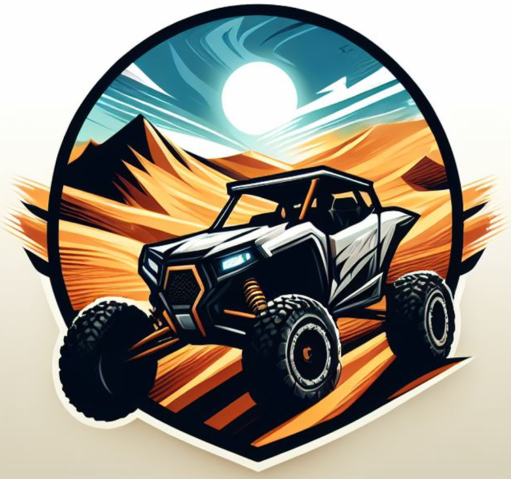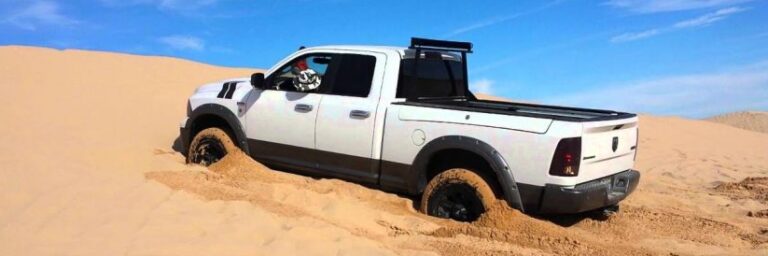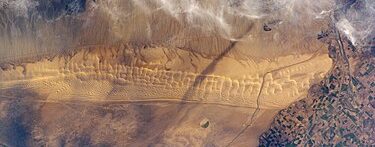The age old question To Paddle or Not To Paddle? Paddle tires are a specialty tire that have a vulcanized scoop on the tire to help move vehicles through the sand. We will touch on the basics of paddles and if a paddle tire is right for your vehicle. For some vehicles it may be a necessity due to lack of power or driving skill. Others vehicles may prefer to run knobbys as it give the ability to drift through corners increase the driving experience. To be an effective dune tire it must create a big footprint (contact with the sand), the larger the footprint the easier the vehicle will move through the sand. Flotation overcomes horsepower meaning a low horsepower vehicle can go anywhere as long as there is flotation. Once the tires dig into the sand, and creates a hole, then more horsepwer is needed to get out of trouble of the tire digging into the sand. In the end Horsepower cures all.
What is a paddle tire?
A paddle tire is a specialty tire that was made for vehicles that travel through the sand. Paddle tires will have a scoop like tread that will dig into and grip the sand and help drive the vehicle forward. There are many factors that make this type of tire effective.

- Molded or buffed tire
- Dimension and width of tire (wider is better)
- How many paddles on the tire-depends on horsepower
- The size of the paddle attached to the tire
- Weight of the tire itself
Many factors like size, weight, and paddle configuration go into choosing the best paddle tire for you. Tire companies offer many options from molded tires to a buffed tire that has vulcanized paddles attached to the tire. There are a ton of molded tire options our the as it is the easiest to mass produce. Using a mold allows the tire to be consistent and it appears how many people think of traditional tire being made. The blank tire is placed in a mold, which is heated, the rubber compound is injected into the mold and creates the tread. Molded tires allow manufactures to create a wide variety of the tread patterns. Typically molded tires are thicker with multiple plys, which lends to a more durable tire that will withstand punctures better. Downside to molded tire is they are typically heavier in overall weight, which will rob horsepower. Check out this Article as to why Dune vehicles should be light.
Buffed Paddle tires start out as a traditional tire. These tires are formed by buffing/grinding the original tread off the tire to take the tire down to almost the core. With this now naked tire the paddle adhesion process can begin. Similar to a molded tire the new paddle tread is vulcanized onto the tire. Manufactures will produce the same size tire with several options with the number of paddles on the tire. If you have a high horspower car then you will need additional paddles. If you have a low horspwer car then the smaller in size paddle or total number will ne needed. A buffed style paddle tire will typically be lighter in weight than a molded paddle tire. the down side is that a buffed tire will be susceptible to punctures due to the thin carcass of the tire. Good examples of companies that Buff the tires is Skat Trak, Sandcraft, Rouge. Companies like Rouge can take any off the shelf road tire buff it down add paddles and make it Sand ready.
SandCraft RCR has a table for SXS demonstrating the number of paddles determined by the horsepower. Not enough paddles and you will spin the tires, Too many paddles and you will be robbing horsepwer trying to move all that sand. It is a delicate process to figure out what is best. Many manufacture provide a rough table to estimate want paddle number for your vehicle.

There are many factors on which paddle is best. For many it comes down to cost. Molded paddles will typical be cheaper in cost as there is not many man hours spent on the tire, but they are typically more resistant to damage. The Buffed tire will cost more but there are several performance factors that may increase. Here is my personal experience in the Paddle/Knobby tire decision process. Current car is a Rzr turbo S came with stock 10ply 32″ coyotes on OEM rims. Total weight per tire 61lbs. These coyotes do not perform well in the sand, they are stiff and aired down to 10 psi they have a hard time providing the traction needed on OEM rims. Previous vehicle was a 16 turbo rzr came with stock 30″ tires. Replaced them with MSA rims and 8 ply 30″ GBC mongrels. Ran those in the dunes at 8 -10 psi for 3 years. Amazing tire in the dunes, provided needed traction and stability while allowing you to drift the RZR through the corners. The newer Turbo S I was trying to lighten the vehicle as it was about 150lbs heavier. So I chose a buffed Sandcraft Destroyer paddle with KMC Beadlock rims. This set up weighs in at 42lbs. Almost 20 pounds per wheel allowing the car to lighten up 80lbs overall, reducing unsprung weight will free up horsepower and make the vehicle more responsive, while allowing the suspensions to work better. With a buffed front this setup worked amazing. I ran the tires at 12 psi and never had an issue with burying the car or getting stuck. Make sure you get the proper Paddle number needed for your horsepower. Too much paddle will actually be a reduce your drivability in the dunes. the tire will try to move to much and and will rob horsepower and speed.
Running knobby style tires
Running knobby tires on your Dune vehicle can be very fun. The ability to slide through the corners sideways is a unique experience. The key is to adjust air pressure in the tires to find what works best for your setup. A good quality Tire Pressure Gauge will allow to make precise adjustments. Remember that with lower air pressure you are more susceptible to “Popping a Bead” meaning the tire separates off the rim and loses all air pressure. A good Quality Beadlock rim will prevent this separation of the tire from the rim. A beadlock rim is a type of rim that has an outer ring that clamp/bolts between the rim and the tire to lock in the tire so it can not separate from the rim. For most applications it is just one ring on the outside of the wheel. There is another non beadlock rim option like the Method Bead Grip wheels. This rim has Patented technology that helps keep the tire seated with Lowered air pressure by adding small grooves that help keep the bead in place.

- lower air pressure (8-15psi)
- Replace rim with beadlock
- Use Method wheels bead grip rim (works really well)
- GBC Mongrel Example to left
To decide which knobby works best you need a tire that provides sidewall strength but still has the ability to flex and get flatten our when air pressure is lowered (creating a larger footprint). Some knobbies have a very stiff sidewall and do not flatten out. For example a 10 ply tires is stiffer tire than an 8 ply. By creating a larger footprint on the sand this allows the vehicle to float on top of the sand. In the dunes flotation is the key you do not want the the tire to dig in into the sand but roll along the top. An example of a tire that works great on hard pack/desert but not good in sand is the Tensor Tire desert series race “DSR”. This tire is proven a winner in Baja but just doesnt provide the flotation needed for the sand.
One of the main keys to running a none paddle tire in the dunes you must learn to keep momentum and choose a line that will allow you to continue speed through the Dunes. Getting stuck in a hole or Witches eye with knobbies can be rather hard to get out of without horsepower or paddles . Without momentum you dont have the ability to float over the sand as much as you need to grip the sand like a paddle to get out. Knobby tires will dig a hole if you have too much air pressure and dont have flotation while trying to start on a slope. Do not park facing uphill always try and park on flat or slightly downhill, with any setup, to prevent this.





